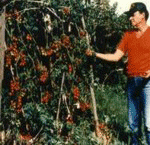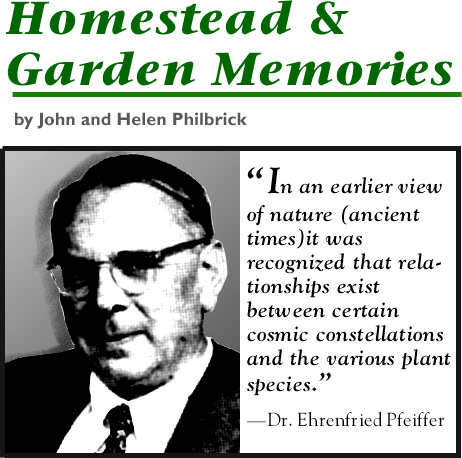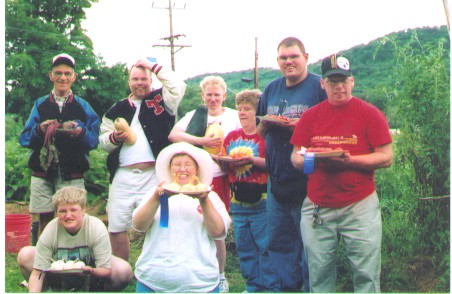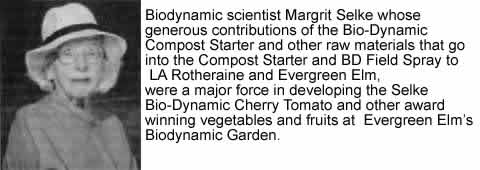 | ||
|
| ||

2000 Cherry Tomatoes From A Single Plant!
Watch this free 15 minute video to learn about biodynamics and see the spectacular results for yourself. Follow the directions to grow your own 12 ft. high cherry tomato plant.
This video first aired on thePBS television program "Take Note"
Biodynamic principles can be applied to gardens or farms of any size, as well as larger areas or whole ecosytems. The following video illustrates how well biodynamics works on single tomato plants.
 |
 Rotheraine's Organic Tomatoes ( Plant) rotheraine.com RETURN OF THE KILLER TOMATOES - Larry Rotheraine picks a few of the more than 2,000 organic tomatoes on his 12x10 foot biodynamic organic cherry tomato plant at his home in Lewis Run. The towering tomato plant was grown in household garbage energized with the biodynamic herbal preparation, called the BD Compost Starter created by Ehrenfried Pfeiffer ( now made by Hugh J. Courtney ) and was made by Margrit Selke. |
Drawn from a memorial article printed in the BIODYNAMICS Commemorative Issue, Winter 1962.
This article originally appeared in a slightly different form in Lilipoh.
When my husband and I try to recall moments spent with Dr. Pfeiffer during our study and application of biodynamics, the memories crowd in almost faster than they can be recorded.
We liked his sense of humor: he showed us a box of earthworms growing in the soil and said, "Science will one day build a monument to the earthworm for all it has done for mankind." He also told us of a new adaptation he was developing to apply to the traditional big-dynamic preparations. This was to be a living bacterial starter which he predicted would be so vital it would be called "bio-dynamite." Subsequent years of experience with Dr. Pfeiffer's Compost Starter have proved the effectiveness of this preparation. (See also McKean County Fair Statistics)
 |
The biodynamic gardeners at Evergreen Elm have again dazzled fair-goers with 28 money finishes out of 29 entries. According to Evergreen Elm's Master Gardener, L. A. Rotheraine, "The secrets for our success this year were the enthusiasm of our biodynamic gardeners and the biodynamic field spray ( created by Ehrenfried Pfeiffer and now made by Hugh J. Courtney ) , that we applied to the soil and plants. We are especially pleased with the three blue ribbons out of three entries in the tomato competition - A blue in the cherry, pear shaped, and plum shaped tomato categories." |
One thing that impressed us from the very beginning was that even though Dr. Pfeiffer stood among the greatest of the scientists of his day, both in America and in Europe, no question was too small for him to consider. He would spend as much time and thought on the small backyard garden as he would on a thousand acre farm. I well remember how he taught us how to determine the amount of moisture desirable in the compost heap: like the amount of moisture in a wrung-out sponge. With his thoroughness, he proceeded with water and a handful of paper towels to show us the consistency of a wrung-out sponge.
Each year, at the Biodynamic Conference, Dr. Pfeiffer had to go back to the beginning to explain botanical and chemical processes to the new students.
Each year he brought us the new discoveries he had just made in the Biochemical Research Laboratory. Once someone asked him, "What will prevent you from getting into trouble with vested interests when you reveal all that biodynamic compost can do and has done?" He answered, "I am looking at the truth. I am not afraid of these pressures. Leading men in the fertilizer business know as much as I do in this field, and they know what their weaknesses are."
When Natural Food Associates (NFA) was organized to educate the public about the values of naturally grown food, Dr. Pfeiffer offered his services, lecturing frequently on current findings from the Biochemical Laboratory. At an early national convention of the N.F.A. Dr. Pfeiffer was introduced as "the foremost soil scientist in the world today." At the conclusion of a most revealing and scholarly address, the audience applauded with so much urgency and appreciation that Dr. Pfeiffer finally returned to the microphone and said, in a tone of voice that showed he was really warmed by their applause, "Your response touches me very deeply." From this I had a new insight into the loneliness of the great man ahead of his time, who discovers truths unused to by his age, only to be appreciated by generations to come. When great sums of money were raised easily for other enterprises, Dr. Pfeiffer often shook his head and said, "If only a small part of that sum could go into biodynamics, it would make a great deal of difference to the nutrition of this country."
Dr. Pfeiffer stood among the greatest of the scientists of his day, both in America and in Europe
As Dr. Pfeiffer's work in the Biochemical Research Laboratory continued, he made more and more scientific discoveries with his amazing skill in ferreting out the secrets of natural phenomena and processes. Some of the material was so technical that amateurs had to work hard to understand.
An intense concern for the process of life, or the life element, (whatever one chooses to call it) was uppermost in Dr. Pfeiffer's research and in his practical applications as a farm advisor. The essence of good composting, as he taught it, was to increase the life of the soil so that quality would go into the crops and animals which fed on that soil. Following his lectures we found we were receiving an education of high caliber which differed from the university training only because it dealt more with living processes than with dead, static, measurable substances.
In conclusion, as the years have unfolded and some of us tried more and more intensively to follow the biodynamic method conscientiously we began to see its benefits. The production of good unsprayed fruits and vegetables is probably the smallest reward, and the greatest value the training in thinking, feeling and willing that has characterized our work. It takes a lot of meditation to really learn about the processes needed for back yard gardening. In all this training, Dr. Pfeiffer has been, and is still, our revered teacher and our beloved friend. Whatever work we do in any field from now on will be better because of his example and his help, and the philosophical and agricultural well-being of all people will, in the far distant future, be improved because he worked patiently, lovingly, honestly to bring the deep truths of Creation within the practical reach of human beings.
While teaching the disciplines of biological growth in scientific terms, Dr. Pfeiffer brought the infiniteness of the universe closer.
This report would be incomplete if it did not return to Dr. Pfeiffer's warm good humor and witty insight. One day he started a lecture by saying, "The powers that be have said we are faddists. The definition of a faddist is 'one who tries first one thing and then another.' Now these so-called powers that be in the agricultural field originally recommended one treatment. That was tried and proven unsuccessful so they recommended another. That proved too dangerous, so they brought still a third: And all the time we have been steadily working on our original method. Just who, exactly, are the real faddists?! "
Note: Helen Philbrick and her husband, the Reverend John Philbrick were drawn to a conference on Bio-Dynamics at Spring Valley in 1943. There they learned gardening methods where "compost was the most interesting". They were members of a loyal company who followed Dr. Pfeiffer from compost to harvests, learning to seek spiritual values in earth-centered work related to weather and calender and cosmos. While teaching the disciplines of biological growth in scientific terms, Dr. Pfeiffer brought the infiniteness of the universe closer.
In 1957 Dr. Pfeiffer was asked to testify as an expert witness at a Long Island dangerous chemical spray trial, and consented, reluctantly. One of the defense attorneys demanded brusquely what fee he was receiving for his testimony. Dr. Pfeiffer replied that there had never been a question of a fee. When asked what he was there for then, Dr. Pfeiffer's answer stated the left-motif of his whole life: "Because I am interested in the future of the human race."
Read another article about Dr. Pfeiffer, "The City With Golden Garbage"

"In the seed we have the stamp or impress of the whole Cosmos - from one cosmic aspect or another. The constellation takes effect in the seed; thereby it receives its special form."
Dr. Rudolf Steiner, 1861-1925, noted scientist and writer. His monumental contributions in the fields of medical science and agriculture are only now being substantiated worldwide.
His courses in medicine and agriculture and the subsequent application over 70 years after his death give hope and light for the future.

Biodynamic, Organic Cherry Tomato Plant Free Seed Give-Away
Challenge the Genetic Engineering Seed Companies
to Create a Plant Like This - They Can't!
Evergreen Elm's Biodynamic Cherry TomatoPlant
Era photo by Alan Hancock
From left, biodynamic gardeners Jim Oehler, L.A. Rotheraine, standing on ladder, Jeff Van Scooter and Brandi Buck stand in front of a 10 foot tall cherry tomato plant on Wednesday afternoon at the Evergreen Elm garden on Elm Street. Rotheraine claims it is the strongest tomato plant on the Planet Earth. “With all the billions of dollars that the genetic engineering seed companies spend, they cannot come close to producing the unique seed that Evergreen Elm makes to create this plant,” Rotheraine said. Evergreen Elm Executive Director Debbie Price said the agency has seeds available from the giant tomato plant. Donations would be accepted.
Copyright 1999 L.A. Rotheraine
First printed in Lilipoh